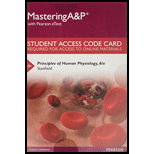
Concept explainers
Introduction:
Pathogens are divided into five classes: bacteria,
Answer to Problem 1E
Solution:
The correct answer is option (b) bacteria.
Explanation of Solution
Explanation/justification for the correct answer:
Option (b) Bacteria. Bacteria are microscopically single celled organism with very simple cell structure. They are the unicellular prokaryotes which lack neatly packed DNA within a nucleus unlike prokaryotes; instead the DNA material is free floating. They also membrane bound organelles.
Explanation for incorrect answer:
Option (a) Virus. The viruses are composed of DNA/RNA fragments encapsulated within protein material. It has no organelles like any other cells and also lacks the capability of dividing.
Option (c) Fungi. The fungi are a member of eukaryotic group which are multicellular organisms. They have chitin in their cell wall that makes them different from other classes like plant or animal.
Option (d) Parasite. Parasites are the organisms that live in another organism called its host. They use host’s
Option (e) None of these. Bacteria are the unicellular organisms among above options, hence this cannot be a correct option.
Bacteria are the unicellular organisms, made up of only one cell and having no defined organelles. Hence, the correct answer is option (b) Bacteria.
Want to see more full solutions like this?
Chapter 23 Solutions
Mastering A&p With Pearson Etext -- Standalone Access Card -- For Principles Of Human Physiology (6th Edition)
 Human Anatomy & Physiology (11th Edition)BiologyISBN:9780134580999Author:Elaine N. Marieb, Katja N. HoehnPublisher:PEARSON
Human Anatomy & Physiology (11th Edition)BiologyISBN:9780134580999Author:Elaine N. Marieb, Katja N. HoehnPublisher:PEARSON Biology 2eBiologyISBN:9781947172517Author:Matthew Douglas, Jung Choi, Mary Ann ClarkPublisher:OpenStax
Biology 2eBiologyISBN:9781947172517Author:Matthew Douglas, Jung Choi, Mary Ann ClarkPublisher:OpenStax Anatomy & PhysiologyBiologyISBN:9781259398629Author:McKinley, Michael P., O'loughlin, Valerie Dean, Bidle, Theresa StouterPublisher:Mcgraw Hill Education,
Anatomy & PhysiologyBiologyISBN:9781259398629Author:McKinley, Michael P., O'loughlin, Valerie Dean, Bidle, Theresa StouterPublisher:Mcgraw Hill Education, Molecular Biology of the Cell (Sixth Edition)BiologyISBN:9780815344322Author:Bruce Alberts, Alexander D. Johnson, Julian Lewis, David Morgan, Martin Raff, Keith Roberts, Peter WalterPublisher:W. W. Norton & Company
Molecular Biology of the Cell (Sixth Edition)BiologyISBN:9780815344322Author:Bruce Alberts, Alexander D. Johnson, Julian Lewis, David Morgan, Martin Raff, Keith Roberts, Peter WalterPublisher:W. W. Norton & Company Laboratory Manual For Human Anatomy & PhysiologyBiologyISBN:9781260159363Author:Martin, Terry R., Prentice-craver, CynthiaPublisher:McGraw-Hill Publishing Co.
Laboratory Manual For Human Anatomy & PhysiologyBiologyISBN:9781260159363Author:Martin, Terry R., Prentice-craver, CynthiaPublisher:McGraw-Hill Publishing Co. Inquiry Into Life (16th Edition)BiologyISBN:9781260231700Author:Sylvia S. Mader, Michael WindelspechtPublisher:McGraw Hill Education
Inquiry Into Life (16th Edition)BiologyISBN:9781260231700Author:Sylvia S. Mader, Michael WindelspechtPublisher:McGraw Hill Education





